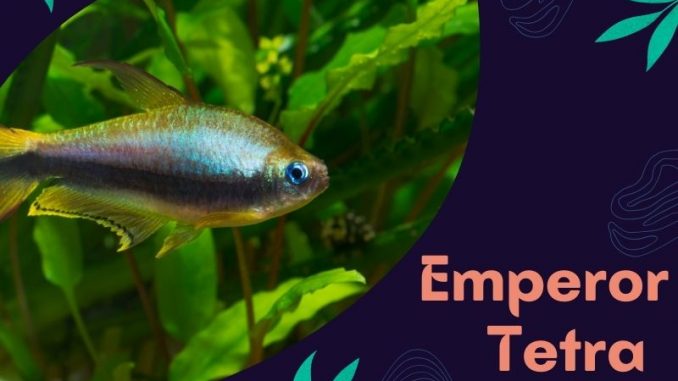
The emperor tetra (Nematobrycon palmeri) is a freshwater fish that belongs to the Characidae family. It is native to the San Juan and Atrato river basins in Colombia.
Like many tetra fish, emperor tetras have long captured the interest of aquarists and first-time fish owners due to the fish’s stunning iridescent scales, peaceful nature, and ease of care.
While emperor tetras will bring a calming and colorful presence to your tank, they are a schooling fish and will need to be kept in a group of at least six.
TABLE OF CONTENTS
Emperor Tetra Facts & Overview
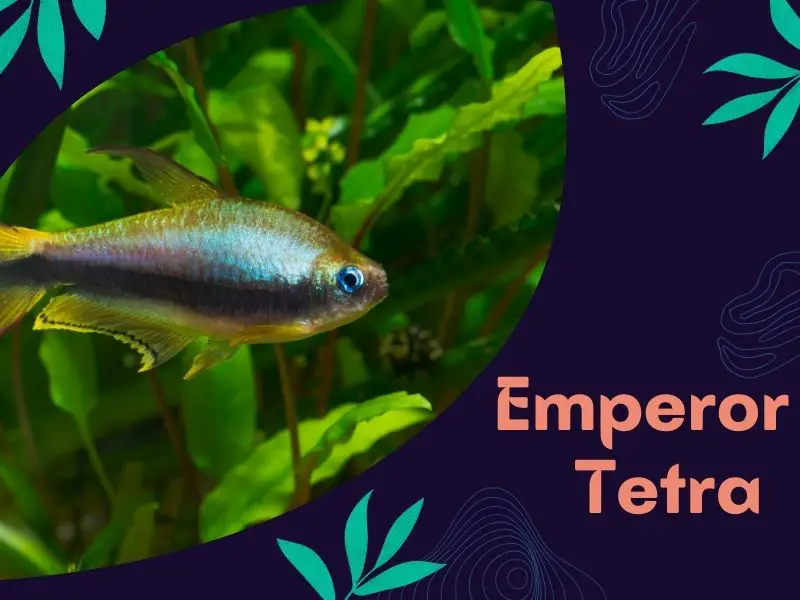
| Category | Rating |
| Care Level: | Easy |
| Temperament: | Peaceful |
| Color: | Blue-gray, purple tones, iridescent |
| Lifespan: | ~5 years |
| Size: | ~2 inches |
| Diet: | Omnivore |
| Family: | Characidae |
| Minimum Tank Size: | 10 gallons |
| Tank Set-Up: | Freshwater, plants, dark substrate |
| Compatibility: | Peaceful, small species |
Emperor tetras are a species of fish belonging to the Characidae family and the order Characiformes. Characterized by features such as toothed jaws and an adipose fin (second back dorsal fin), this family is predominantly made up of species of tetra fish. While every tetra is unique in its own way, almost all have a docile nature.
As their name suggests, emperor tetras have an air of elegance about them, from their regal looks to their dignified swimming style.
In the wild, emperor tetras live within the San Juan and Atrato river basins, preferring slow-moving water that’s around 72°F to 81°F. These areas are quiet, dark, and have dense vegetation. With appropriate care, emperors usually live up to 5 years in a tank.
Emperor tetras are popular among the fishkeeping community and can be found in pet stores worldwide. On average, they cost between $2 to $5, but this may vary depending on their size, age, and location. While inexpensive, they are schooling fish. You will need to purchase at least six – the more company, the safer and more comfortable they’ll feel.
The International Union for Conservation of Nature (IUCN) does not consider them a threatened species.
Appearance & Behavior
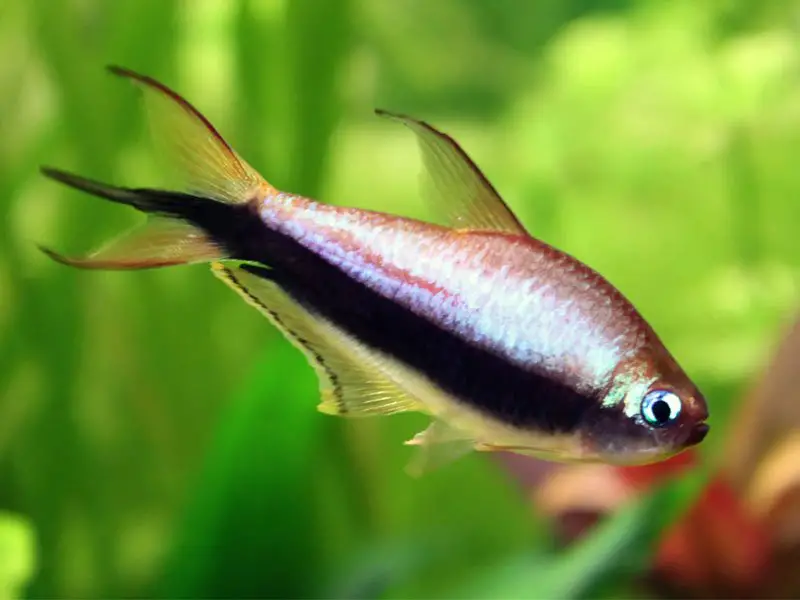
Emperor tetras are a small freshwater species. The average adult is 2 inches, but they can sometimes grow up to 2.5 inches.
Emperors have elongated bodies and large, blue-grayish scales. The scales have an iridescent purple sheen that stands out in low lighting. The top of the emperor’s back is an umber hue. Their fins are translucent and have a yellow coloration, though the outer edges are tinted black.
Another distinct feature of the emperor is a black stripe that runs across their entire body. Beneath the stripe, the coloration tends to be lighter. Emperor tetras are sexually dysmorphic, so looks do vary based on sex. Males have a larger, more pointed body, and have longer dorsal (top) fins, and a longer caudal (tail) fin. Their caudal fin also has an elongated ray in the center, which gives their tail a trident-like shape.
Females tend to be plumper and less colorful. Their iris hue is also different: male emperors have blue eyes, while females have green eyes. Emperor tetras come in a black color variation too.
When stressed, an emperor tetra’s scales may dull and lose color. Stress also makes tetras more vulnerable to bacterial and fungal infections, which can cause visible growths or rashes. Several factors can cause stress, including abrupt change in water parameters, an insufficient group size, and inappropriate lighting.
Typical Behavior
Emperor tetras are docile and friendly schooling fish that thrive in the company of their own or other peaceful species. They are quite lively and active and will dart around the tank with a dignified air.
Tetras are mid dwellers, but they may swim down to the lower levels of the tank to explore and take cover in plants. While they rarely exhibit aggression, the males can be territorial with each other. However, fights seldom lead to injuries, especially if the tank is spacious and set up appropriately.
Emperor tetras can be fin nippers, and sometimes more boisterous male tetras will chase other fish. Keeping them in a large school will help to prevent this behavior. A larger group size will also allow tetras to show off their vibrant colors and swimming patterns.
Tetras are diurnal, which means they are active throughout the day and rest during the night. It is not always obvious when an emperor tetra is sleeping, but there are some visible changes. They will become inactive, and they tend to stay in the same position. Their coloration can also change, becoming noticeably duller or paler.
Not all tetras will experience color changes at night though since every fish has a different level of rest.
Emperor Tetra Care
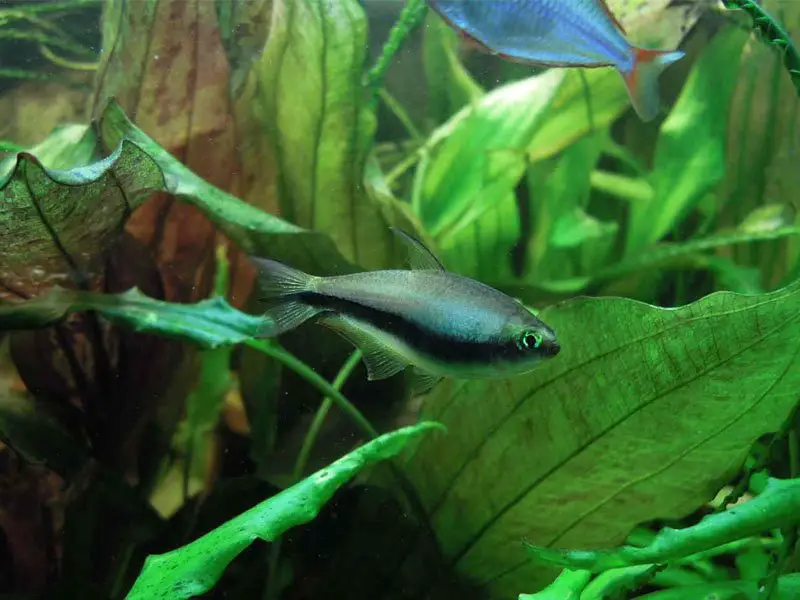
While the emperor tetras are hardy and one of the easiest species of fish to look after, that doesn’t mean they don’t have individual needs that need to be catered for. Emperor tetras are also particularly prone to stress, making it even more important that they receive the proper care.
Emperor tetras thrive in freshwater with a dark substrate, plenty of vegetation, and dim lighting, an environment that resembles the Colombian rivers they’re originally from. They can tolerate various water conditions, but just like any fish, they can get sick if the water is not well-maintained. Water should be changed regularly, with at least one partial water change (25%) every 2 weeks.
Tetras are omnivorous and will eat almost anything, including flake foods and live foods like brine shrimp.
While the emperor tetra doesn’t experience any species-specific diseases or problems, they are prone to diseases that typically affect freshwater fish, such as fin rot and ich.
Changing water regularly and providing your tetras with a balanced and nutritious diet can reduce the chances of a disease outbreak. Ensuring their home is a “stress-free environment” is also a must.
Habitat and Tank Requirements
An emperor tetra’s natural habitat is the tropical rivers of Colombia. Most of their population is found in the San Juan and Atrato river basins, which are heavily vegetated and have gentle water currents.
Although the water itself is warm, vegetation and foliage keep the river shaded from the sun. These basins also contain blackwater environments, where the water is stained and turned acidic from the tannins of decaying vegetation.
If you wish to introduce emperor tetras to your aquarium, you’ll ideally need to replicate these conditions.
Tank Conditions
The water should be kept warm with the optimal temperature being 72°F to 81°F. The water should also have a pH balance between 5.5 to 7.5. Peat filtration is advised to keep the water soft (3 to 8 dkH) and acidic, as well as to keep ammonia levels at a healthy level.
However, tetras are hardy, since virtually all in the trade are now captive-bred. While they prefer moderately soft water, they can thrive in harder water as long as the water is well-maintained and changed regularly.
Make sure you decorate the tank with plenty of live plants (like hornwort). Emperor tetras love to hide and explore, and the plants will allow them to do just this. The plants will also provide tetras with a shaded place to shelter, giving them a greater sense of security and safety. Plus, dense vegetation will reduce the chances of aggression, since emperor tetras can easily keep out of one another’s view.
You should also incorporate driftwood and some caves. These decorations will serve the same purpose as the plants, and help emperor tetras to feel at home. Substrate-wise, opt for dark-colored sand.
Emperor tetras prefer subdued lighting, and a darker environment will bring out their iridescent hues. Try to limit harsh artificial lighting and keep the room’s curtains closed. If you’re unable to adjust the lighting of the room itself for whatever reason, add floating plants to the aquarium. Floating plants will help keep the water shaded.
You can also replicate the blackwater environment by adding decaying (dried) leaves at the top. However, you’ll need to replace these leaves every few weeks to prevent them from dirtying up the tank.
When choosing a water filter, make sure it doesn’t generate strong currents. Emperors are accustomed to slow-moving water. Decorations can help to spread out the current.
The tank should be at least 10 gallons, but the actual size will depend on several factors. For example, while 10 gallons will accommodate a small group of emperor tetras, a larger group will need a bigger tank. Otherwise, it could become overcrowded.
If you’re introducing tetras to a community tank – where there are multiple species of fish – you should be looking at a 30-gallon fish tank or more.
Generally, you should follow the “one inch of fish per gallon of water” rule, but remember that this is the bare minimum, and a rough estimate only.
Since emperors are active fish and enjoy exploring, we advise opting for a tank at least 25 inches in length. Plus, you’ll need to invest in one with a solid and secure lid. Tetras are renowned for jumping out of their tank.
Tank Mates
Emperor tetras are schooling fish that are happiest in a group of six or more. Ideally, it’s best to have only one male within the group or enough females to prevent competition and fighting.
Emperors are also docile, making them ideal for community tanks. They get along well with peaceful species, including other tetras, danios, rasboras, and corydoras. Dwarf cichlids, guppies, and pencil fish are also great options, as they share the same home region (South America) and habitat preferences.
However, there are some exceptions. Tetras are quiet and won’t feel at ease around more boisterous, lively species, such as bettas. You should also stick to fish that are similar in size. Larger fish, like angelfish, may mistake tetras for food.
Emperor tetras are compatible with many species of freshwater aquarium snails too. They are even compatible with African dwarf frogs.
Diet and Feeding
Tetra fish are omnivores and are not overly picky about food. In the wild, their diet usually consists of larvae, worms, insects, algae, and crustaceans.
In a tank, tetra fish will be more than happy to eat nutritious flakes or pellets. They will also eat live or frozen food, such as mosquito larvae and brine shrimp. Feeding tetra live and frozen food will help to bring out their coloration.
You should feed your tetra fish 2 to 3 times daily. This will replicate their natural, opportunistic eating habits – they eat whenever they have the opportunity, so they’re accustomed to multiple meals throughout the day.
The food should be a size they can easily swallow and digest. Avoid giving them food that they won’t be able to fully eat within 2 minutes, as this can lead to pollution. This is especially the case since emperor tetras are mid swimmers. They won’t eat food that ends up at the bottom.
If you notice that they haven’t eaten all of the food, clear up the leftovers straight away.
Breeding
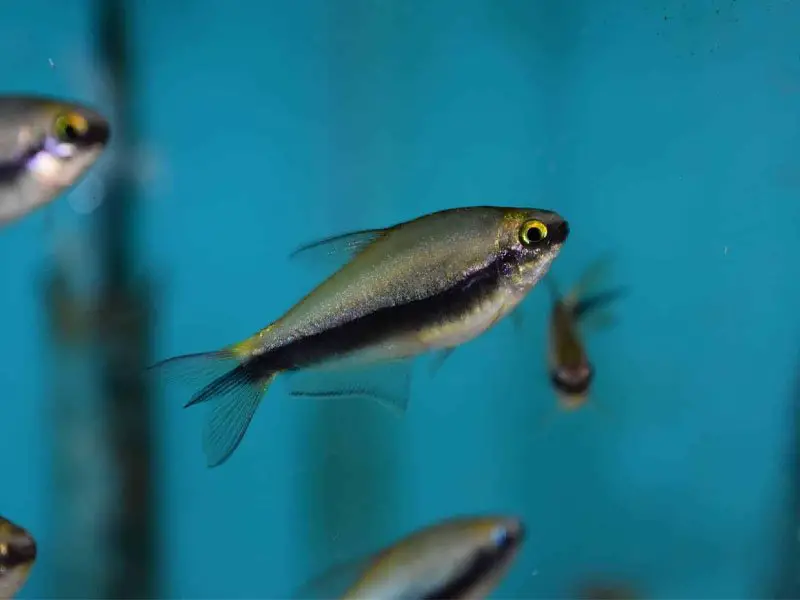
Emperor tetras are egg scatterers. In large schools, breeding typically happens naturally. You can encourage breeding by ensuring the right tank conditions are met, and by feeding them live and frozen foods like Daphnia (planktonic crustacean). If a female is ready to lay eggs, she will become noticeably plumper.
You will need to create a breeding tank for your tetra pair to ensure the fry (baby fish) have the best chance of survival. If you have multiple breeding pairs, make sure they’re kept separate and have their own tank. Otherwise, they’ll likely exhibit aggression toward one another, especially when spawning (egg-laying).
The breeding tank needs to mostly replicate their preferred water condition and be regularly maintained. Keep the water soft and the pH around 7.0. The water should also be at a higher temperature (slowly increase to around 82°F).
Don’t forget to add lots of dense vegetation into the breeding tank for the female tetra to deposit her eggs. You can also use a floating spawning mop.
You will also need to use a sponge filter. Sponge filters provide gentler filtration and are a safer alternative for fry (baby fish) than standard filters. A standard filter may suck in the fry.
Besides the plants (or mop) and sponge filter, you do not need to set up anything else. Doing so will only make the breeding tank harder to clean.
On average, female tetras spread between 50 to 130 eggs in the tank. The egg-laying process can take several hours. Tetras often eat their own eggs, so it’s advisable to remove the parents immediately after spawning occurs. If there is no sign of eggs after a few days, replace the breeding pair with a different pair.
The fry usually hatch within 48 hours. Once they are free-swimming, you should feed them infusoria. As they grow, you can gradually transition them to brine shrimp.
Fry are extremely sensitive to pH changes, so make sure you keep the pH level the same. The breeding tank should be kept dark, as they’re also sensitive to light.
Should You Get an Emperor Tetra for Your Aquarium?
Emperor tetras are a fantastic option for a community aquarium. They are peaceful, easy to care for, and get along well with many species. They are also hardy, making them beginner-friendly, too.
That said, emperors won’t work for everyone. They aren’t compatible with larger fish, since they’ll likely be mistaken for prey due to their small size. They also prefer a quiet environment – boisterous fish like betta will stress them out.
With the right water conditions and tank mates though, emperor tetras will thrive. They’ll bring a splash of color to your tank with their iridescent quality and mesmerizing swimming patterns.



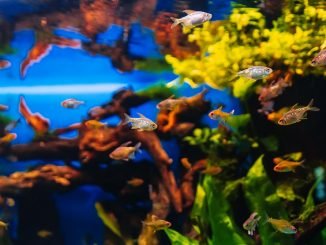
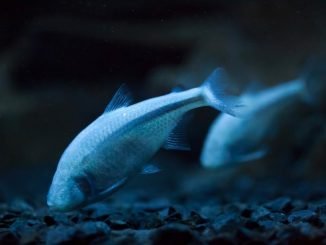
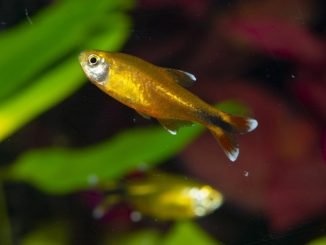
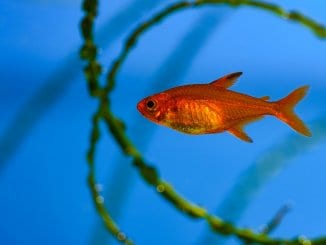
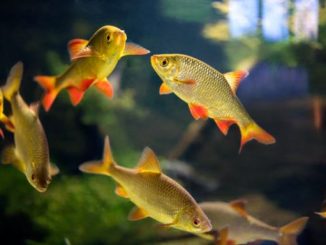
Be the first to comment